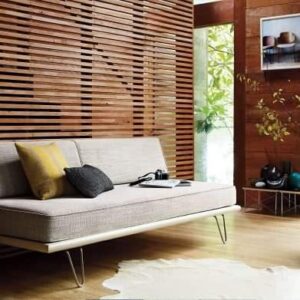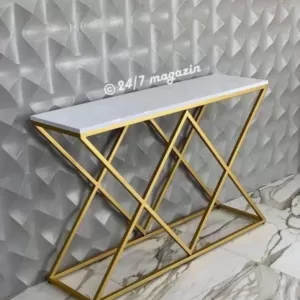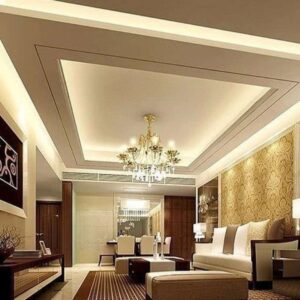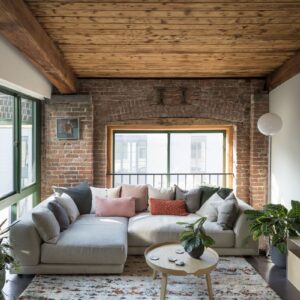A Detailed Guide on Decorating the Living Room of Your Dreams
The living room is unquestionably one of the most significant rooms in your home. Your living room serves as your entertainment hub, the location of scrumptious family movie nights, and the gathering point for visitors. Hence, it is understandable if you feel a little intimidated about decorating this significant area. Not to fear, we’ll show you how to decorate a living room such that it appears to have been taken from out of a magazine.
One thing needs to be done before you can put any of your living room design ideas on paper: measuring. If you don’t measure every nook and cranny, your entire living room design—including the window treatments, furniture, and rugs—could be inaccurate or incompatible with the room.
The layout of the space will be constrained by walls that have windows, doors, or insets, so pay close attention to these places. Take this sketch with you when you go shopping. That will aid in avoiding mishaps and ordering furniture that is the wrong size.
Nobody wants to PIVOT their brand-new leather sofa into their brand-new fantasized living space.
Picture the Layout
Thinking about the layout of your living room doesn’t require you to be an architect or interior designer. You can have a better sense of the furniture you need to buy if you take the time to create a blueprint of your room.
It might assist you in determining whether you have adequate room for your long sectional sofa or your new bar cabinet. It can also make you realize that perhaps you won’t have enough space to install that extra cabinet to display your family’s serve ware collection.
As you begin to imagine what your living space will look like, consider your layout or floor plan. Next, priorities where you want each of the key items in the room to be placed after making a list of them.
Do you need help designing a layout? You can use one of the many floor planning programmers available, or our team of professional designers will design the ideal living room arrangement for you.
Choose Your Style
The hardest part of designing your living room is this. But, figuring out how you want to live will establish the parameters for where and how you’ll go furniture shopping. Choose the design aesthetic you want to emphasize: modern, contemporary, informal, warm, farmhouse, or welcoming. Selecting a style might assist you in determining what you require.
Think about it:
In what capacity will I be using my living room?
How many people will typically be present there?
Do I intend to host events?
Is it fun for me to watch TV in the living room?
Even though these appear unconnected, they can help you determine the kind of furniture you’ll require.
For instance, purchasing a comfy sectional sofa may be more vital than adding accent chairs if you know you’ll spend time watching TV in the living room. A loveseat combined with accent chairs and ottomans, on the other hand, can provide you more freedom to design a conversation-starting seating area if you’re going to host parties.
Find the Sofa First
When you search for living room ideas, the sofa frequently appears in the top results. It makes sense because the couch, which is likely the largest piece of furniture in your living room, will determine how the other furnishings are arranged.
Look for a couch that will serve as your centre point. Don’t forget to consider how your living room can be used. A sectional is a better choice than a loveseat if you anticipate spending a lot of time in this space watching television.
The sofa’s material will also be more significant given lifestyle factors like pets and kids.
When selecting an accent piece, a sizable sofa, or experimenting with different seating arrangements, be careful not to overcrowd the area. While you want your seating area to be cozy, you also want to make sure there is enough space for people to move around without constantly tripping over the sofa or coffee table’s edges.
Pick the Area Rug
When buying area rugs, it might be difficult to decide what you need. Choose a rug that is large enough to accommodate all of your living room furnishings. The ideal distance between the margins of the carpet and the room walls should be between 10 and 20 inches. Keep in mind that a living room will look disconnected if the area rugs are too tiny.
These days, you can even stack various area rugs to provide depth and texture. Consider combining various forms and textures to create an elaborate pattern that will give the living room a more grounded appearance if you want an exciting appearance.
Get the Right Lighting
You need three different forms of lighting in your living room: ambient, task, and accent. You may use a combination of wall sconces for ambient lighting, table and floor lamps adjacent to the main sofa for accent lighting, and above chandeliers to achieve this. Before you buy lighting, be careful to have a general idea of how your living room will be set up because lighting may be rather tricky.
Lighting is an area where you can have some fun. We frequently receive inquiries such as “Should I use two matching lamps?” The reply is: You’re not required to! You can experiment with the pieces you add based on the design of your living room.
For instance, you might use a floor lamp that provides distinct illumination on one side and a statement lamp that matches your side table on the other. You not only select the appropriate lighting for each area of your living room, but you also increase the number of items in the room to give it a more interesting appearance.
Here are some lighting suggestions for your house to get you motivated.
Decide on Your Color Palette
Choosing the ideal paint color is essential when it comes to living room ideas. Choose a color scheme that goes well with the furnishings you’ve chosen, the overall design of your house, and the look you want to accomplish in this space.
Don’t forget to consider steps four and five together because choosing the proper paint colors will also depend much on lighting.
Keep in mind that you can combine different colors and decor styles. In your living area, don’t be afraid to mix colors, patterns, and styles. To avoid making the room appear cluttered, though, make sure that there is a unifying theme, whether it is the color, the style, or the subject.
Add Wall Art & Accessories
Without wall art and accessories, no living room decor ideas would be complete. Don’t go overboard and believe that the entire space must be filled. Because it gives your eyes a place to rest, empty space is essential when constructing comfortable spaces. Wall art and other decorations, such as pillows, blankets, mirrors, and decorative items, will tie the room together and finish the appearance.
It can be difficult to select art that fits your home. So, when choosing your wall art, consider the entire motif. Keep in mind that when you add wall accessories, these are frequently items that reflect your personality and are very personal choices. Some elements can be more purposeful, like a large floor mirror placed over a narrow wall to enlarge the appearance of the space.
More Tips on How to Decorate a Living Room
Whatever your taste, there is an art to designing a space that complements your aesthetic. Here are some pointers on how to style a living room like an expert now that you know the fundamentals.
Mix Light and Dark Paint Colors
We are accustomed to viewing rooms in a single color. Nevertheless, when you mix light and dark living room paint colors, you produce a dynamic style that gives your area depth and harmony. To get you started, look at some of the most popular living room paint colors.
Contrast Neutral Colors
On the same vein, keep in mind that neutral hues can also be contrasted. For instance, brass hardware and caramel leather details might contrast sharply against white walls. Contrasting tones offer the palette a deeper feel and a striking appearance as you begin to add additional color and texture.
Play With Texture
If you don’t feel comfortable utilizing color to create a distinctive design, try employing various textures. Leather, cotton, wool, stone, glass, and a variety of other textures are among the numerous that you can use to enhance texture.
Mix Your Upholstery
Try mixing up your upholstery as you get more imaginative and playful in your furniture selections. To add personality to your decor and to break up the trend, mix and match elements. Combining leather chairs with fabric sofas or vice versa is one of the safest methods to accomplish this.
Choose Movable Furniture
Make sure the tables, stools, and ottomans you choose are simple to move. This will provide you with a wide range of possibilities and make your living area more lively and flexible.
How should I begin to style my living room?
The aforementioned advice ought to get you started on organizing the layout and design of your living room. Try to begin modestly. A complete revamping effort could otherwise be too overwhelming. Most individuals typically start by choosing the rug, sofa, and accent wall art. Work your way around your TV and media centre to begin making this a pleasant and conversational place.
How can I make my living room look nicer?
With a few simple steps, you can effortlessly beautify your living space. To avoid the room being too monochromatic, try adding more color with pillows, rugs, and decorative accents. By selecting tables and chairs with elaborate legs, you can use furniture to decorate as well. Selecting statement lighting fixtures that go with the decor will help your lighting become a part of your decor. To help you keep focused, try to implement all of these suggestions in accordance with a single theme.
How can I affordably decorate my living room?
To make an impression, your living room doesn’t need to be completely redone. To tinker with the arrangement and alter the appearance of your living space, start by moving the furniture about. Upgrade your art wall decor with family photos, prints, and readily available posters by purchasing a few frames. To elevate the space, add indoor plants. You might also consider painting one or two walls to add depth. These simple modifications can drastically improve the appearance of your living area without costing a fortune.
What Kind of Services Does Living Room Interior Design Offer?
Typical living room interior design services comprise:
Making a functional and visually acceptable layout for the living room is called space planning.
Consultation on color schemes: A designer may assist you in selecting a color scheme for your living room that harmonizes with the current furnishings and evokes the desired atmosphere.
Lighting design: The look and feel of a living space can be significantly changed by appropriate lighting. You can get assistance from an interior designer in selecting and installing the ideal lighting fixtures for your room.
A designer can assist you in making a fashionable and comfortable furniture decision that complements the size and configuration of your living space.
Accessories and decor: To round off the aesthetic of your living room, an interior designer can assist you in choosing decorative pieces like throw cushions, art, and carpets.
Bespoke window treatments: A designer may assist you in selecting and installing window coverings that improve your living room’s insulation, privacy, and style.
Custom built-ins and other storage options: An interior designer can assist you in designing and installing custom built-ins and other storage options if your living room needs more storage.
How Do I Choose a Design for My Living Room?
While choosing a living room design, there are numerous things to take into account. Here are some guidelines you can use to pick a design that suits you:
Choose your style: Which type of design does you like best? Do you like a more traditional style or something more trendy and contemporary? Try to choose a living room design that compliments the overall decor of your house.
Evaluate the room’s purpose: Consider how you plan to use the living room. Are you going to use it largely for family time or do you need a place to entertain guests? This will assist you in choosing the style and arrangement of the furnishings.
Establish your budget: While choosing a living room design, it’s crucial to keep your budget in mind. This will enable you to reduce your alternatives and make sure you don’t go over budget.
Measure the space: It’s a good idea to measure the space where you plan to put the furniture before you start shopping. This will enable you to calculate the size of the parts that will fit and the available space.
Think about the lighting: A living room needs good lighting. Think about the amount of natural light the space has as well as the kind of artificial lighting you’ll require.
Consider color: Choose a color scheme for your living room that expresses your particular style and harmonizes with the architecture of your house as a whole.
Don’t forget about storage: Ensure that your living area has ample space for all of your possessions. To keep things organized, think of including bookcases, cabinets, or even a storage ottoman.
Which color combinations work best for living rooms?
When it comes to choosing the ideal color schemes for a living room, there are no absolute laws. In the end, the colors you select should express your individual taste and flair. Having stated that, the following color schemes can be used in a living room:
Neutral colors: A living room can have a relaxing and well-coordinated appearance by using neutral colors like beige, grey, and white. Using decorations like throw pillows or artwork, you may add color pops.
Monochromatic scheme: Selecting variations of the same color can give a living room a polished and coherent appearance. For a unified appearance, you may, for instance, choose blue hues ranging from light to dark.
Colors that go together harmoniously: Opposing hues on the color wheel, like blue and orange, can give a living space a powerful and striking appearance.
Selecting colors that are adjacent to each other on the color wheel, such as green and blue, can give a living room a unified and harmonious appearance.
Dark and light contrast: A living room can have a stunning and opulent appearance by combining a dark color, like navy, with a light neutral, like white or beige.
It’s a good idea to experiment with several color schemes to see which ones suit your space the best. When choosing colors, you can also take into account the lighting in your living room as well as the general design and décor of your house.
Clean lines, neutral colors, and a focus on functionality are the hallmarks of modern living rooms. The furniture in these living rooms is frequently sleek and basic, and there may be a variety of textures and geometric shapes present. The goal of creating a coherent, clean environment in modern living rooms is the main objective.
Using exposed brick, pipes, and concrete as important design components, industrial living spaces embrace the unfinished and unpolished. These living rooms frequently incorporate vintage and contemporary furnishings and may have a rustic or urban feel. In industrial living rooms, the raw materials and textures of the room are highlighted.
Traditional Living Room Design: Traditional living rooms are elegant and comfortable, and they are everlasting classics. They frequently have elaborate embellishments, including crown molding, and might feel formal or more formal. The goal of traditional living rooms is to create a cozy and inviting ambiance.








